With a studio based at Indwe Park in Braamfontein, Hannelie Warrington-Coetzee is a relational artist who is as passionate about the environment as she is about art. With a Master of Science from the University of the Witwatersrand, she uses her work to "interrogate the role of art as a medium for social action". This makes her art relational because it takes as a starting point the relationship between us as human beings and our social context. Using various media, and both permanent and temporary installations, Coetzee uses as a foundation for her art the immediate community, and aims to "connect the participants to the intervention."
Central to her art is research, and she dedicates a substantial portion of her time to developing nature-based solutions and public art installations that aim to create a partnership between people and the natural environment to resolve social issues. Some of the most memorable of these include the Eco Tree Seat (2019), the Kwa Mai Mai Wildwall (2023), and most recently, the Plant Pee Pot (2024). She also regularly collaborates with other institutions and organisations, including Global Change Institute at the University of the Witwatersrand, Water for the Future, and Johannesburg Development Agency.
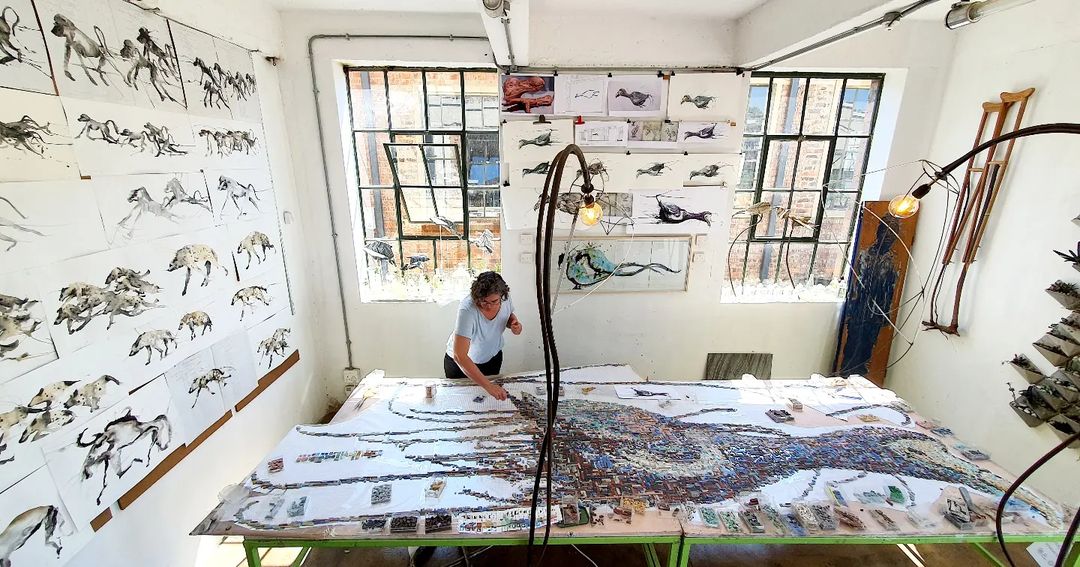
As a visual artist, Coetzee uses her transdisciplinary background as inspiration for her art. One of her most recent exhibitions, Hadeda Murmuration, is a (surprising) celebration of one of South Africa's most well-known and infamous birds. Inspired simultaneously by her work in ecology and conservation, and the afvlerk hadeda, Hettie, who lives in her garden, she combines social conventions and perceptions, scientific knowledge, and artistic endeavour to bring together people and the natural world. In the past, she has also used her knowledge of – and fascination by – South Africa's fauna and flora (such as the hyena, Joburg's jacaranda trees, wildebeest, and grasshoppers) to create beautiful sculptures and artworks that pay homage to our environment in a sincere yet memorable way.
We spoke to Coetzee about her love for the environment, her passion for art, her relationship with previous generations, and what it means to be a resident of Joburg.
“My parents called [Joburg] 'Sodom and Gomorrah,' so, of course, I had to see it. I was also excited about job opportunities and learning about the world on my own terms. Joburg gave me this and much more. There is an endless supply of surprises.”
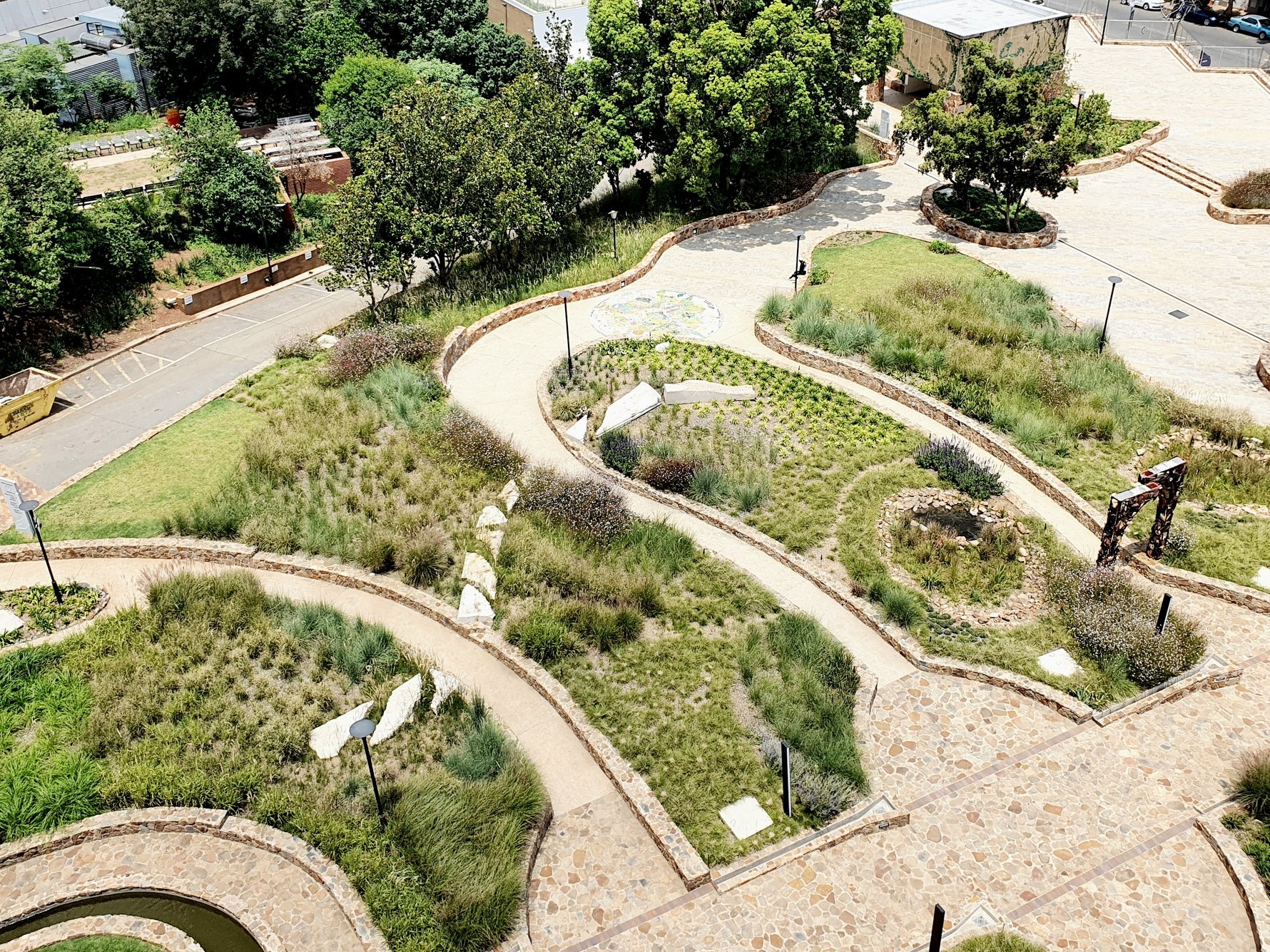
Photo: Hannelie Coetzee.
What prompted your recent studio move to Braamfontein's Indwe Park?
Who wouldn't want to be an artist-in-residence in a park? On a more serious note, I was looking for a new space in the city with a different view of Joburg. Literally and figuratively. My affiliation with the Wits Global Change Institute opened a door to Indwe Park because they are also based here. Since my emergency spinal operation, my praxis matured into, I suppose, more strategic work. Along with my Master's in Environmental Science (2022), I now wear an art and science cap when looking at the city. It is such a treat to sit on the intercontinental watershed and simmer on plans to build healthier cities. It's already a very productive new space connecting inside and outside worlds, introducing informal and formal knowledge systems to each other.
We don't often get to picture artists in full PPE and gumboots, searching for the eye of the Jukskei River underneath the city. Yet this was you in 2020. Tell us why ongoing research and fieldwork are so central to your practice.
I learn by doing. I am a kinaesthetic learner, so when I go on a field excursion, things fall into place, either immediately or eventually. By going on official police-escorted, subterranean immersion with equally curious engineers, I see the natural ecosystems beneath the city. They are not as yucky as one might imagine. In fact, it is less of a mess down there than on street level. I like to make work in the real world, about the real world, and connect the dots to try and make a meaningful contribution. Hence, my art has become increasingly regenerative, especially because of my environmental focus. I frequently ask myself: how do we fix this mess by linking the wealth of other types of knowledge we have to existing failing systems in our diverse city?
"So, for a few years, I made works of my ancestors and their lives when they came through Johannesburg. All those early works taught me how welcoming Johannesburg is, and how open-hearted people are. I just had to start listening... and participate in this complex city. Once I contextualised all the family kak I got more interested in the ecology creeping through the cracks."
Tell us about your recent artist-in-residence stint at Tswalu Kalahari Reserve's field research centre?
I walked with a pangolin in the moonlight! I tried to draw it while walking but my kit was a bit unrefined. So, I am building another kit to draw while walking in the moonlight. I watched wild dogs play! One night a researcher woke me up at 1 am because these wild dogs were playing with clothes left on the washing line right outside the house. They had just eaten and were full of energy. It was mesmerising to be mere metres from them, kneeling at eye level and watching these painted wild dogs play. I drew the pangolin, the wild dogs, the puffadders being studied, and some Korannaberg landscapes. The proximity to these beings and moving around their habitat has left an indelible mark on me. A body of work is simmering. The artists-in-residence programme at Tswalu (a studio which Everard Read Gallery initiated before the pandemic) can be split over multiple visits which suits my iterative approach very well. I will revisit it over the next year and see how it evolves into a body of work. I also brought back a few very dry, twirly pieces of wood…
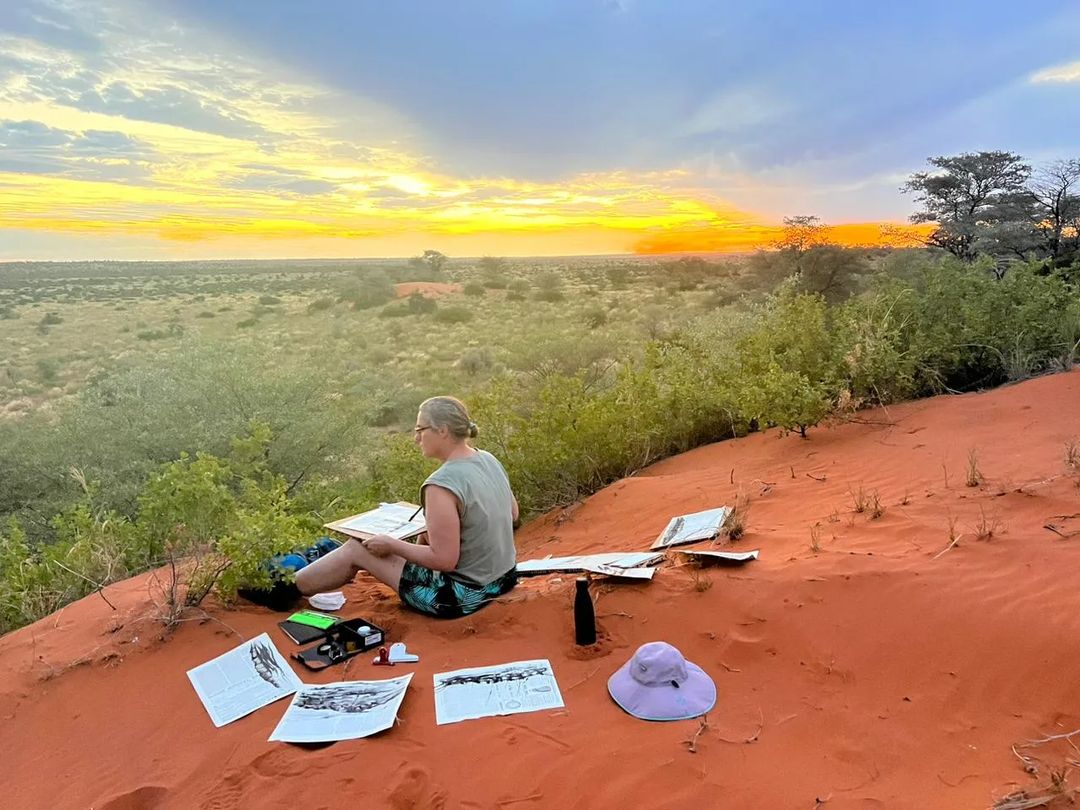
Creatures great and small are a recurring theme in your work. What have your close observations of the animal kingdom taught you about living and human nature?
Wild animals have it all sorted. Their social lives are dynamic and diverse. We must simply observe them zoomorphically and not anthropomorphically and then we can learn the best survival strategies from both fauna and flora. Their world is not heteronormative and not solely focused on reproduction. Being queer and child-free is not an anomaly in their worlds. When I know I am about to have an encounter with a new wild animal, I read up on the animal, so that I understand what I am looking at when I have that moment with this creature in the wild. And I just let it be. While they show their genius, I try and capture some of the spontaneity by dipping ink into rooibos tea, making marks on the paper and letting the wind whip the paper with me in the way they move.
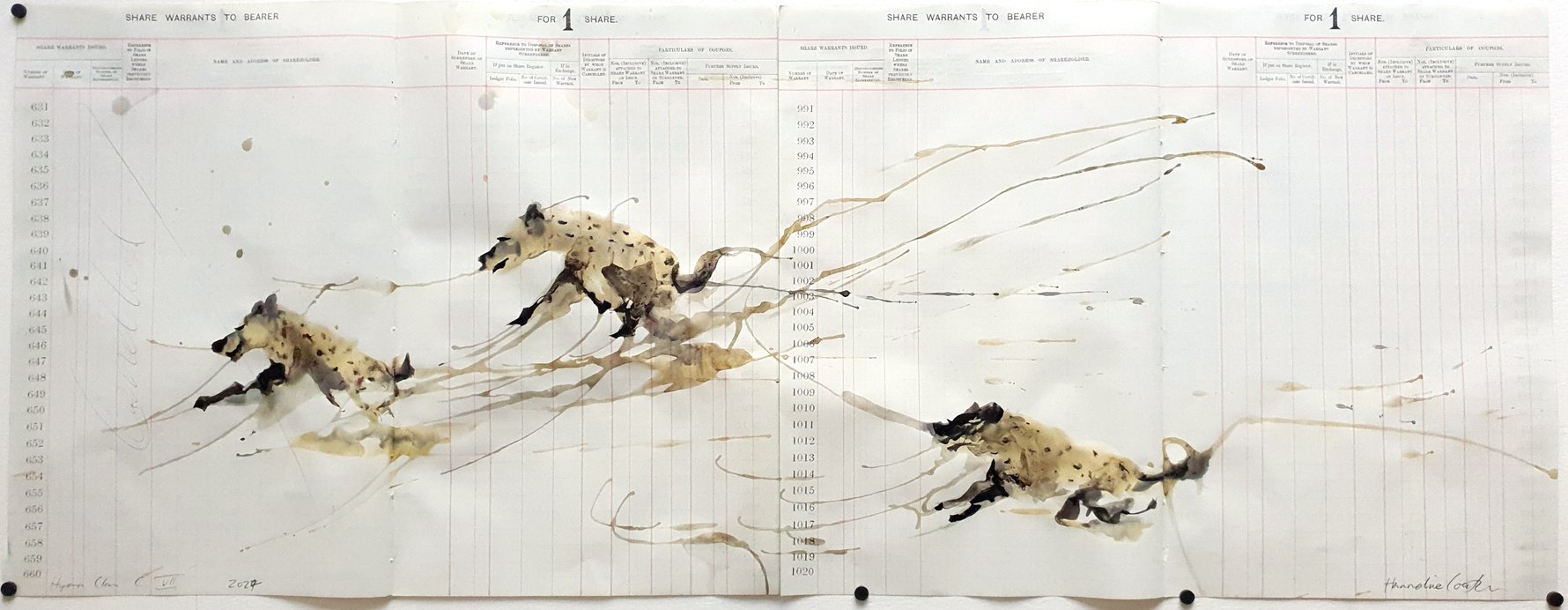
From your great aunt "Tant Koek" to your Oumagrootjie, you've memorialised important female ancestors of yours in murals around the city. Engaging with your personal history in public spaces in this way, what have been your reflections?
When I first started making art in public spaces, I was struggling with wrapping my head around some intergenerational family issues I inherited. I wanted to understand it but also let it go. So, for a few years, I made works of my ancestors and their lives when they came through Johannesburg. All those early works taught me how welcoming Johannesburg is, and how open-hearted people are. I just had to start listening to what was going on around me and participate in this complex city. Once I contextualised all the family kak I got more interested in the ecology creeping through the cracks.
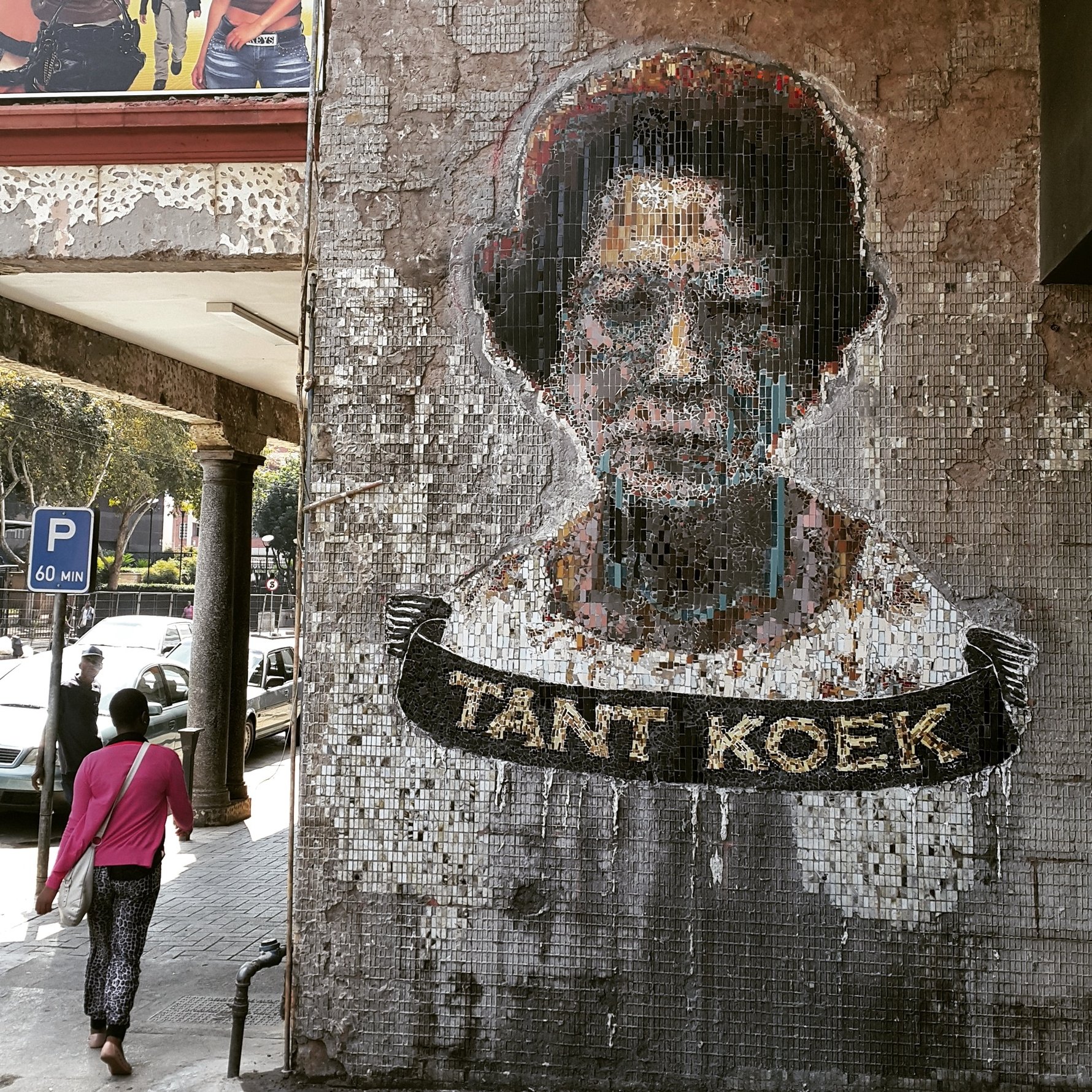
Tell us more about the use of found materials in your work, and how this enables you to orient it in particular spaces.
The public can sometimes be put off art as too fancy or complicated. I like to carefully select material which might connect incidental viewers because the material I use becomes a boundary object in itself. It intrigues people; they see something familiar, used in a different context. And it prevents obsolete objects from going into landfills. As part of the ongoing upper Jukskei Regeneration Project [Jukskei River Regeneration Collective] run by Water for the Future (which I co-founded), the gardeners kept bringing me old metal pieces that they had dug up. The creatures I build from it give a second life to those rusty pieces of metal.
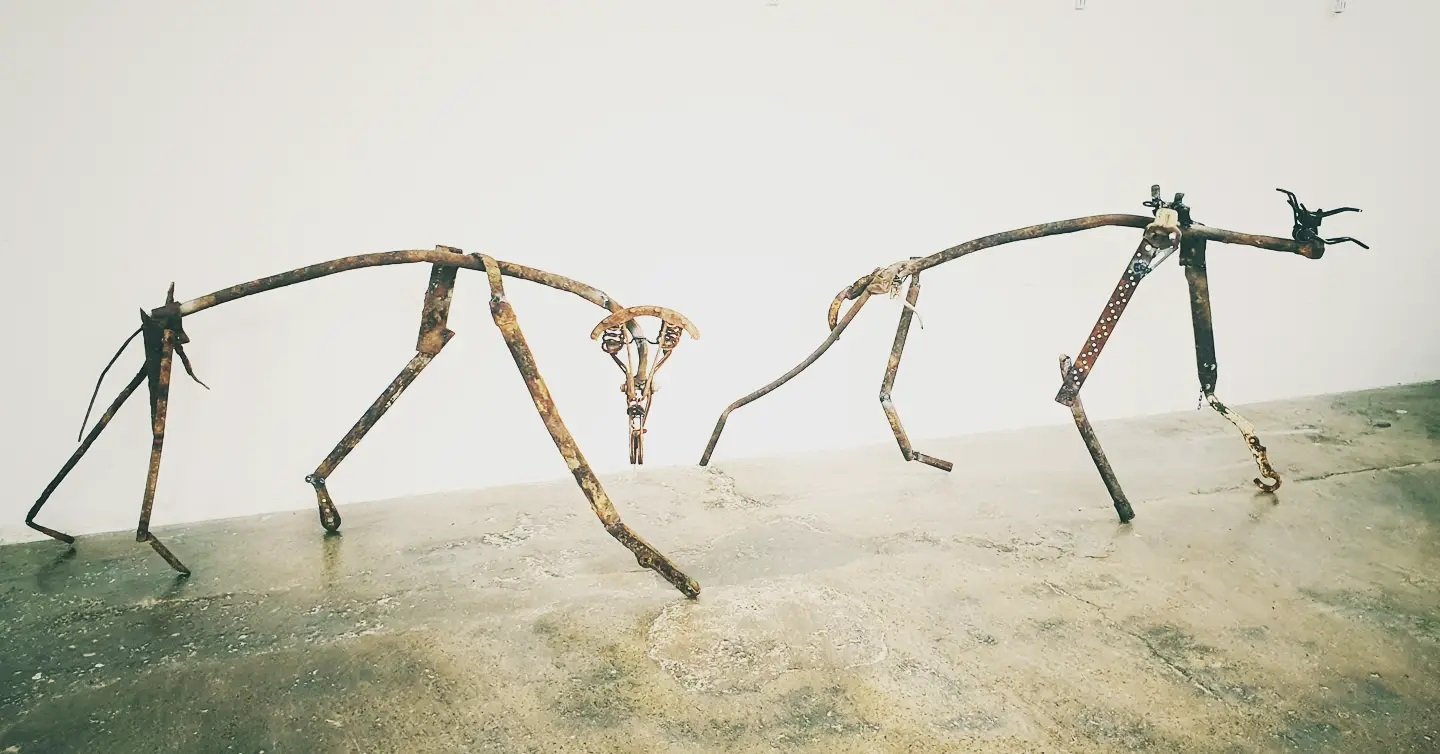
You recently completed a project under the highway bridge in Maboneng that involved the creation of pissoirs. Tell us about this.
Over the years I have built up a network of like-minded artists, journalists, scientists, architects, and city planners, to name but a few fields. At the beginning of 2023, urban designer Stefan van Niekerk asked me what we can do about public urination. I immediately went into problem-solving mode and looked at 1) artworks I studied as part of my MSc. and 2) my network of specific scientists. Since my GIBS Social Entrepreneurship course in 2013, I have been keen on using phytoremediation science, where plant growth strategies [are harnessed] to clean up [pollution]. This was my chance. I started researching phytoremediation and quickly built the pilot Plant Pee Pot, also known as the P.P. Pot, at Victoria Yards, and then a few in Maboneng to test it on the street. We had an Honours study looking at how much urine the plants can handle. As we were building confidence with this public experiment supported by science, UJ Peets came on board and did CAD drawings for us. It has now run for a full year and the plants are doing well. So we are ready to scale it in cities all over the world. Although it needs watering and topping up, the biggest bonus is the P.P. Pots do not need to be connected to the sewerage system.
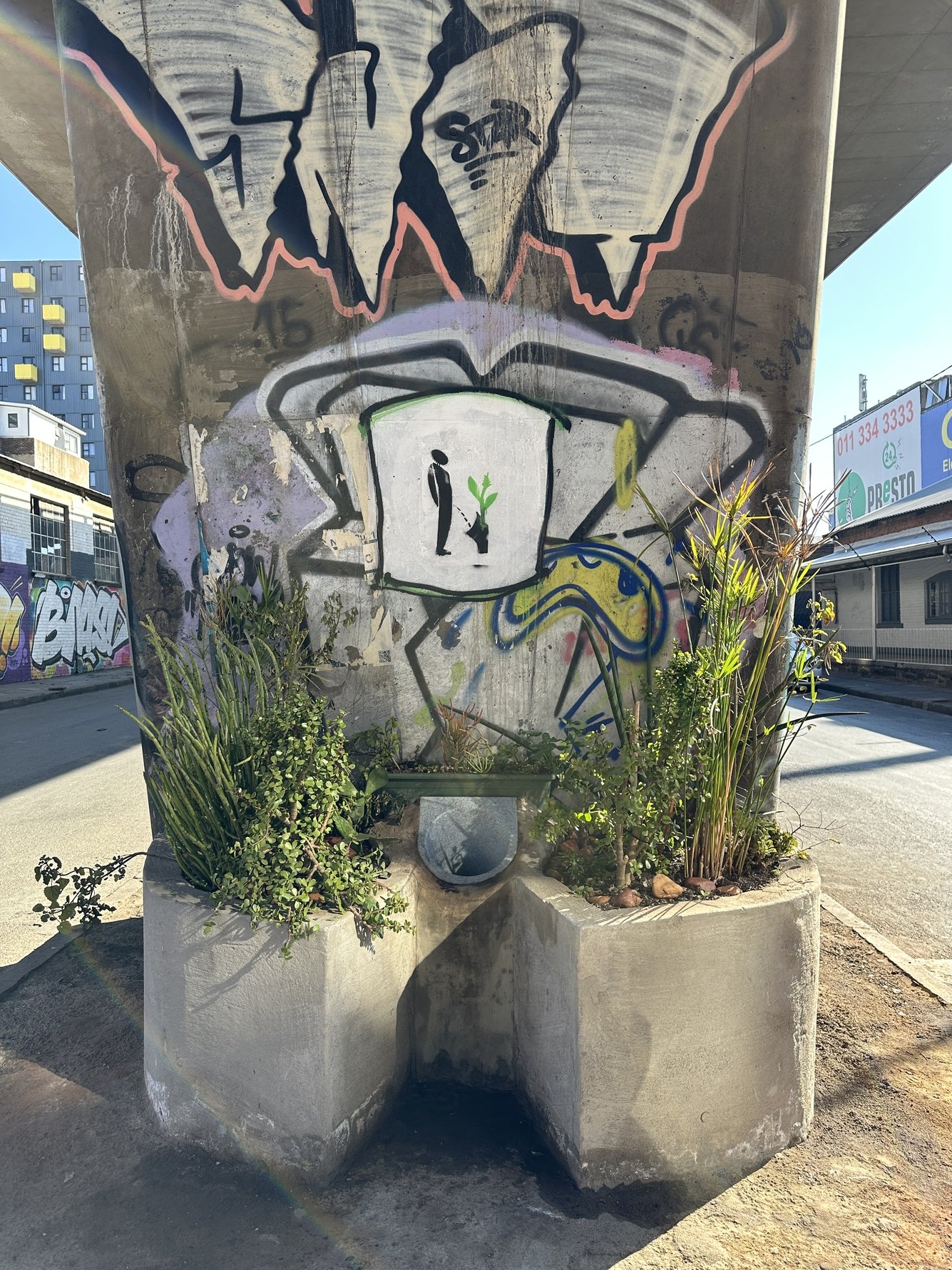
Photo: Johannesburg In Your Pocket.
How do you view the role of art and artists in South African society?
Relational artists like myself do not want to be separate from, or aloof to, society. I want to work with society using nature-based solutions to improve life for all beings. If us in-betweeners are paired up with industry, the natural world can play a vital role in greening our cities. We are already connecting, seeking each other out. My work outside of the art scene has been very meaningful to make sense of life and build careful contributions that take the harsh concrete edge off the city.
What brought you to Joburg and, or, what makes you stay here?
My parents called it 'Sodom and Gomorrah,' so, of course, I had to see it. I was also excited about job opportunities and learning about the world on my own terms. Joburg gave me this and much more. There is an endless supply of surprises.
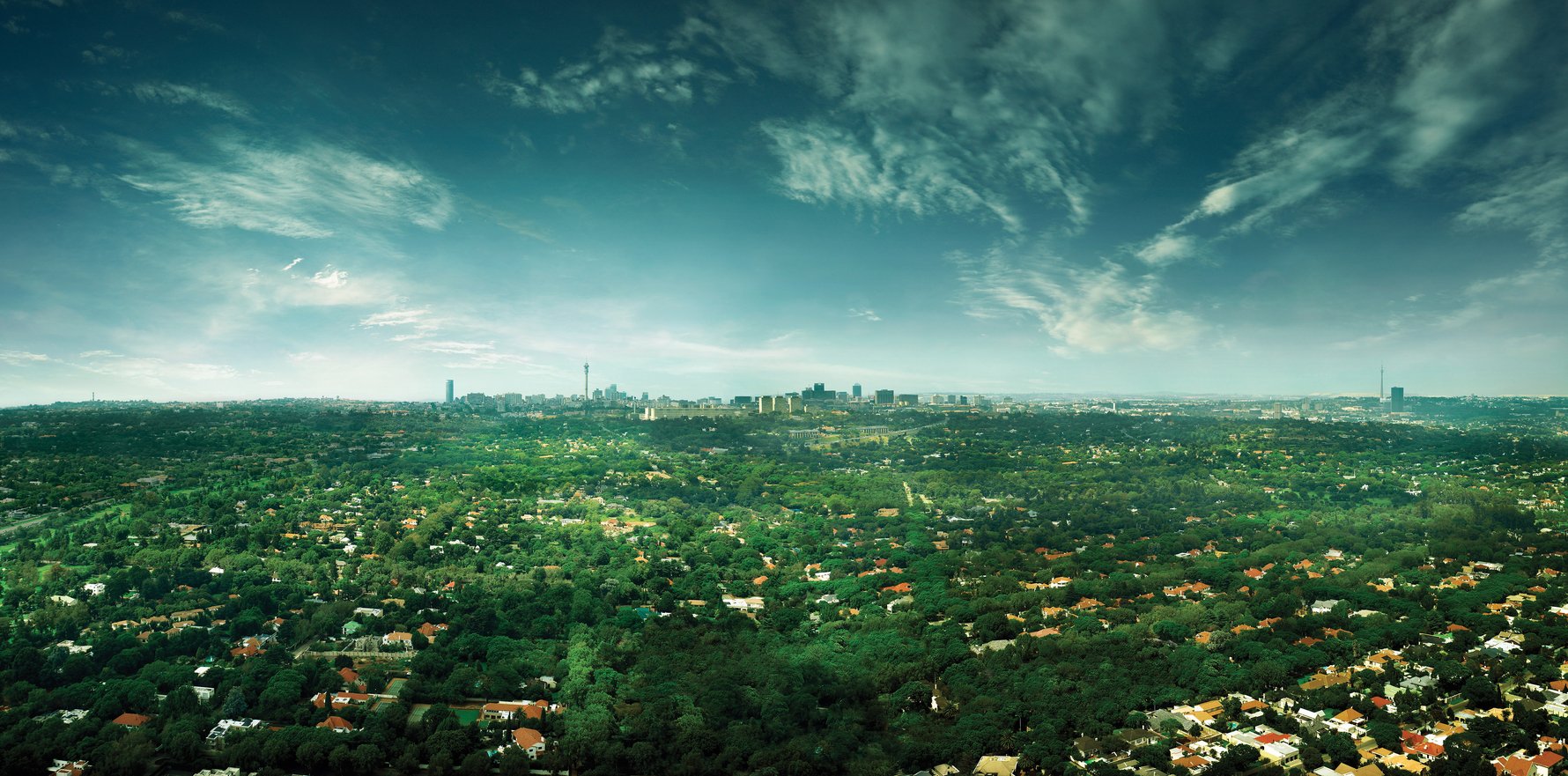
Your favourite Joburg suburb, and why you choose it?
I love the Parks.
What is a surprising thing people might learn about Joburg by having a conversation with you?
It has an intercontinental watershed; we pollute the Atlantic and Indian Oceans!
What three things should a visitor not leave Joburg without seeing or experiencing?
The 100-year-old Cork oak tree at Berea High School, the magnetic, contorted rock exposed on Melle Road in Braam which indicated the gold reef back in 1886, and book an urban art tour with me to view some gems.
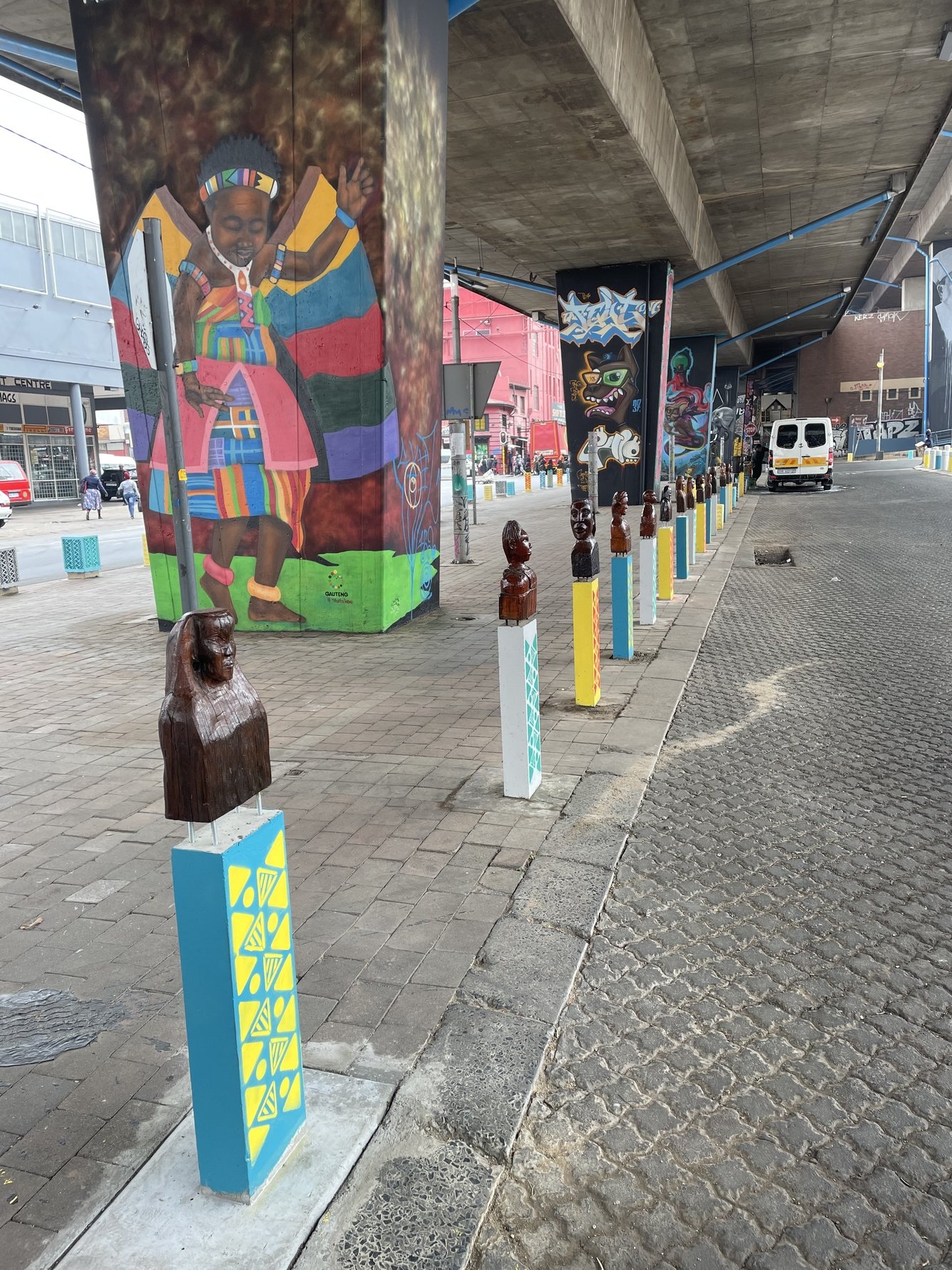
Your favourite Joburg author or favourite Joburg book?
My wife, Réney Warrington, wrote Smit Motors. It's a celebration of how normal queerness is!
One song on your Joburg soundtrack that either is about Joburg or makes you think about this city?
Die Woud by the band Bittereinder.
The most memorable meal you have eaten in Joburg?
Réney and I celebrated a combined 50th birthday at The Pot Luck Club in Rosebank. It was an unforgettable evening.
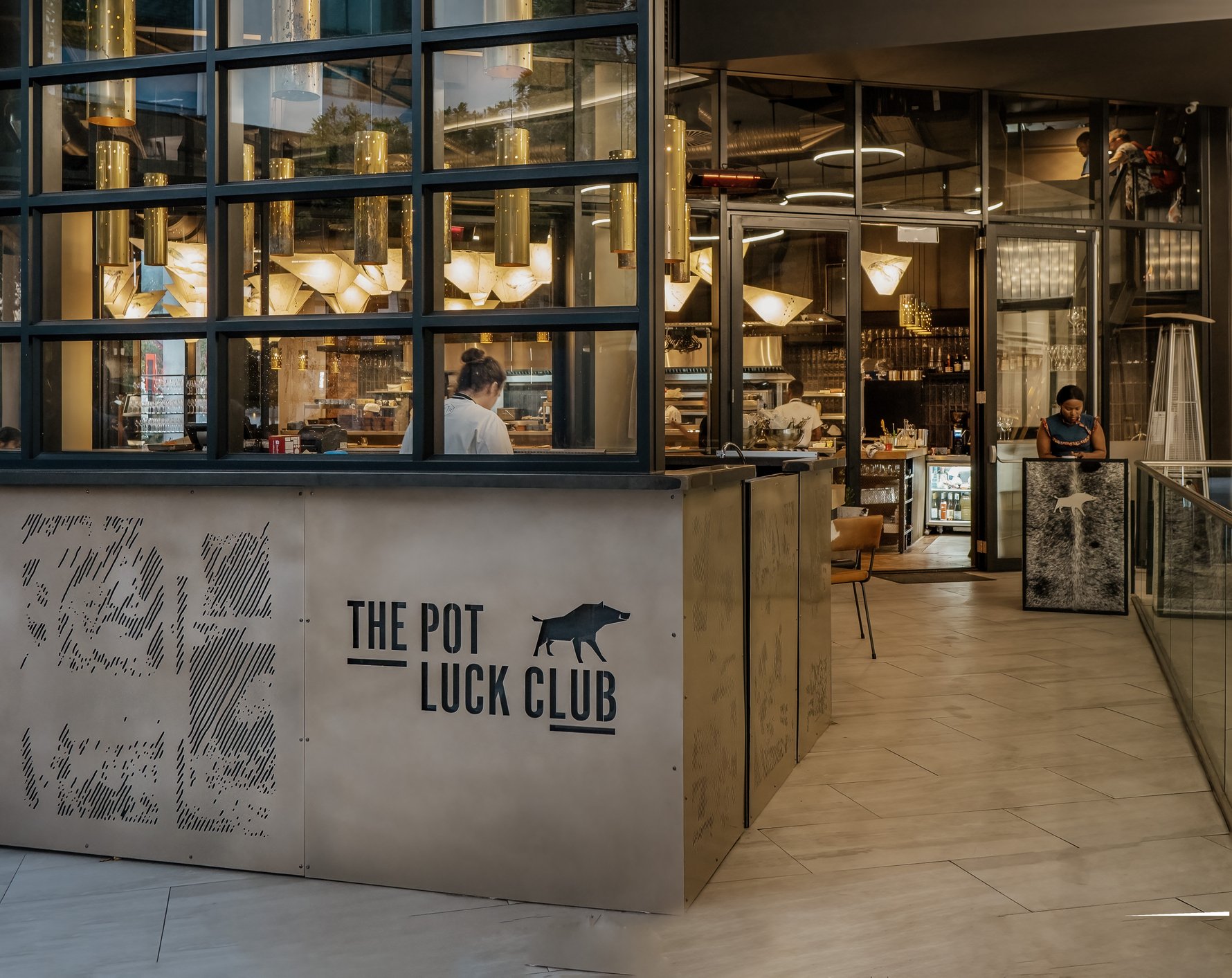
If you could buy one Joburg building which would it be?
The old, boarded-up petrol station in Parkview. It is not for sale. I tried.
If you were the Joburg mayor for one day (average tenure) what would you change?
I don’t know if I want to be the mayor to change things. I think building agency with active citizenry is a better job to have. These top-down systems irk me.
Favourite Joburg label, and why?
Wrapt Knitwear. Their locally sourced natural fibre knitwear and edgy design keep me warm every winter.
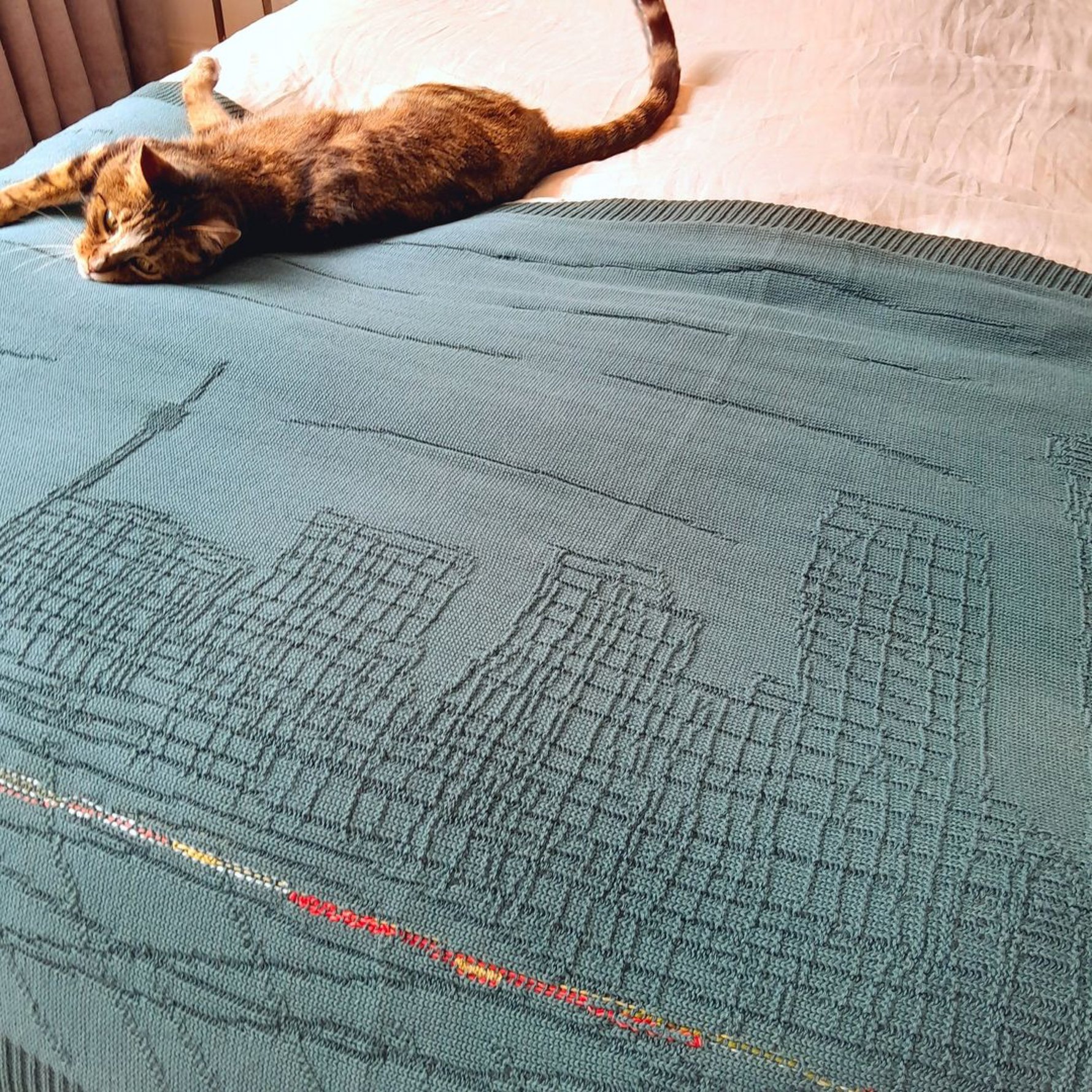
What makes someone a Joburger?
Greeting someone with, "Howzit."
What do you love most about Joburg?
The weather.
What do you least like about Joburg?
The crime.
Your number-one tip for a first-time visitor to Joburg?
Go around town with some locals.
One Joburg personality whom you would honour with the freedom of the city if you could, and why?
Kennedy Tembo from Microadventure Tours. An iconic Joburger making things happen with such an open heart. [Editor's note: One of our favourites too]
The perfect weekend in Joburg includes...
A walk in Walter Sisulu National Botanical Garden.
Three words that describe this city.
Entrepreneurial opportunity galore!
Check out some of our previous #MyJoburg interviews for more insights into the city:
#MyJoburg with Nickolaus Bauer, journalist and Dlala Nje co-founder
#MyJoburg by writer Jo Buitendach
#MyJoburg with artist Thabang Lehobye


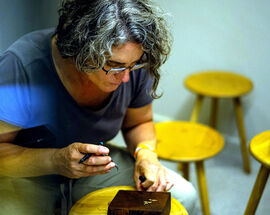
' by Hannelie Coetzee in Fordsburg, Johannesburg - 2010 RW - ph Hannelie Coetzee_m.jpg)
 (1)_m.jpg)


Comments